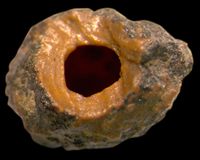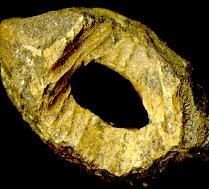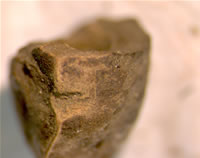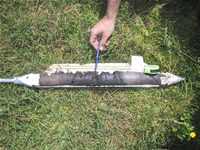Dating human arrival in New Zealand

Radiocarbon dating of Pacific rat (kiore) bones and rat-gnawed native seeds have provided compelling new evidence into the timing of New Zealand’s colonisation.
The pacific rat (kiore) spread with voyaging humans; therefore, its earliest presence in New Zealand indicates initial human contact. Radiocarbon dating of kiore bones suggests they were introduced to New Zealand c. ad 100 (Holdaway, 1996 Nature). However, these radiocarbon ages are controversial because there is no supporting ecological and archaeological evidence for the presence of kiore or humans until c. ad 1280 -1300.
An international team of researchers, led by Dr Janet Wilmshurst from Landcare Research, spent 4 years on a study which shows conclusively that the earliest evidence for human colonisation is about 1280-1300 AD, and no earlier. They based their results on new radiocarbon dating of Pacific rat bones and rat-gnawed seeds. Their results do not support previous radiocarbon dating of Pacific rat bones.
Their study is the first time that the actual sites involved in the original study have been re-excavated and analyzed. Furthermore, the reliability of the bone dating has been questioned, with explanations for their anomalously old ages ranging from variations in laboratory pre treatments to bone contamination through either post-mortem processes or dietary- related offsets. Work, funded by the Royal Society of New Zealand Marsden Fund, has resolved the debate using several approaches.
The study, one of the largest studies of its kind, has shown that the country was not visited by humans over 2000 years ago, as some previous research suggests. The work is published in the journal Proceedings of the National Academy of Sciences in the United States.Outcomes, achievements, and highlights
- Established a reliable date for kiore arrival by radiocarbon dating kiore-gnawed seeds preserved in sediments. This bypasses the problems of bone dating.
- Tested the reliability of the early kiore bone ages by re-dating new rat bones and investigating bone contamination problems using new pre treatment procedures and isotope analyses.
Dr Wilmshurst and her team researchers re-excavated and re-dated bones from nearly all of the previously investigated sites. All of their new radiocarbon dates on kiore bones are no older than 1280 AD. This is consistent with other evidence from the oldest dated archaeological sites, Māori whakapapa, widespread forest clearance by fire and a decline in the population of marine and land-based fauna.
As the Pacific rat or kiore cannot swim very far, it can only have arrived in New Zealand with people on board their canoes, either as cargo or stowaways. Therefore, the earliest evidence of the Pacific rat in New Zealand must indicate the arrival of people.
The dating of the rat bones was also supported by the dating of over a hundred woody seeds, many of which had distinctive tell-tale rat bite marks, preserved in peat and swamp sites from the North and South Islands.
 |
 |
 |
| Close up of a rat-gnawed matai (Prumnopitys taxifolia) showing the distinctive gnaw marks left by the incisors of the Pacific rat. Image - J Wilmshurst | Close up of a rat-gnawed miro endocarp (Prumnopitys ferruginea ) showing the distinctive gnaw marks left by the incisors of the Pacific rat. Image - J Wilmshurst | This is a preserved kaka-cracked miro - you can see a distinctive notch on the side from where the bird has gripped the nut, and then a sharp clean cracked surface where the bird has sheared the nut open using its powerful beak. Image - J Wilmshurst). |
These rat-gnawed seeds provide strong additional evidence for the arrival of rats, and therefore humans, and are an indirect way of testing the veracity of the dates we have done on rat bones. Rats leave rows of narrow grooves or bite marks on woody seed cases when they gnaw open the seed, and these distinctive teeth marks can be seen with the naked eye. The width of the teeth marks left on the woody seeds exactly match those of a rat's two front teeth, and cannot be mistaken for any other seed predator.
In our search for rat-gnawed seeds we also found evidence of past native seed predator on the tough little miro (Prumnopitys ferruginea) nuts which are only about 12 mm long but extremely hard. In contrast to the rat-gnawed holes and bite marks, the native kaka (Nestor meridionalis) leave their own distinctive signature of opening up these tough little nuts.
We have dated over 100 individual seeds, some rat-gnawed, others intact or bird-cracked, which show that rat gnawed seeds only occur in both the North and South Islands of New Zealand after about 1280 AD.
 |
This is a D-section core collected from Te Rerenga in the Coromandel peninsula. The pen is pointing to a rat-gnawed seed found in-situ within the dark sandy layer. This layer is the distinctive Kaharoa ash which erupted 1314 ±12 AD. The presence of rat-gnawed seeds in this ash means that 1314 AD provides an upper age limit for initial rat arrival in New Zealand. Image - J Wilmshurst |
 |
A selection of rat-gnawed matai (Prumnopitys taxifolia) nuts collected from spit 0-10cm, in Nguroa Bay, North West Nelson. The bite marks from rat incisors are well preserved in these seeds which were radiocarbon dated. These seeds date from 1550-1650 cal yrs AD. Image - J Wilmshurst |
Searching for gnawed seeds is a time consuming and laborious task, a little like looking for a needle in a haystack. Janet Wilmshurst and Tom Higham looked for sites with peat deposits drained by farmers, exposing sections which could be searched by coring and by digging test pits.
In all of the seed sites that we studied, no rat gnawed seeds were older than 1250-1300 AD, the only seeds that date before this are either whole or show signs of bird predation. This completely supports the picture that has emerged from our new rat bone dating.
With over 165 dates on seeds and bones from a large number of sites, the overwhelming evidence suggests that rats and their human carriers did not reach New Zealand until about 1280 AD. The earliest dates for rat and human arrival are strikingly consistent with the oldest dates from archaeological sites, the first large clearances of forest by fire, and declines or extinctions of marine and land-based fauna. It now seems certain that the first Māori settlers arrived in New Zealand sometime about 1280 AD. The consistent picture emerging now is that settlement was much later than the old rat bone dates led many people to believe.
This age has several important implications; firstly rat predation only began after 1280 which is much shorter period than previously implied and makes the risk to currently declining populations of rat-sensitive species more pressing as they could be diminishing faster than previously assumed. Secondly, colonisation did not involve a protracted delay between initial discovery and subsequent colonisation, an idea implicit in earlier theories. The first people arriving in New Zealand from tropical East Polynesia initiated an immediate and rapid transformation.
A precise date for the arrival of the rat helps us to fully understand both the history of human settlement and the past and present ecological impacts of kiore on native fauna and flora. It also allows the human settlement of New Zealand to be placed more accurately in the context of the broader settlement pattern of East Polynesia.
Dr Wilmshurst and her colleagues are now turning their attention to other islands in East Polynesia where similar controversies exist over the timing of initial human settlement. Dates on rat-gnawed seeds and rat bones are likely to be just as helpful in resolving controversies on other Pacific islands where rats were also introduced prehistorically.
The team
 |
The team of researchers from left to right: Janet Wilmshurst (Landcare Research), Tom Higham (Oxford University), Atholl Anderson (Australian National University) and front Trevor Worthy (University of Adelaide) at Earthquakes #1, Otago during their reexcavation of this key laughing owl site. (Photo Alan Tennyson). |
